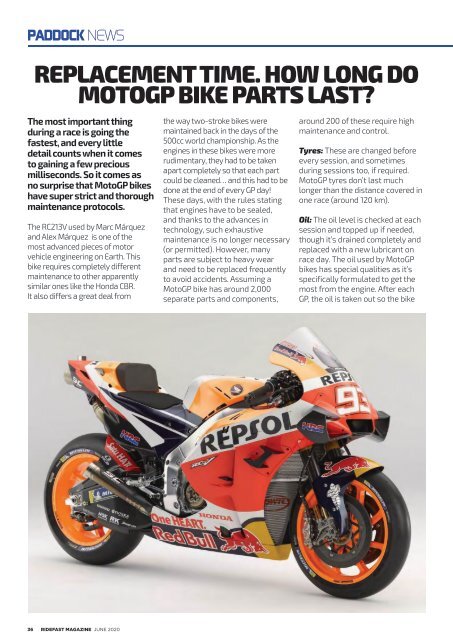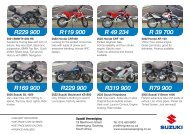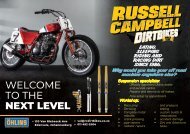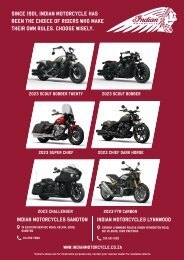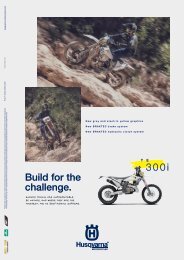RideFast June 2020
You also want an ePaper? Increase the reach of your titles
YUMPU automatically turns print PDFs into web optimized ePapers that Google loves.
PADDOCK NEWS<br />
REPLACEMENT TIME. HOW LONG DO<br />
MOTOGP BIKE PARTS LAST?<br />
The most important thing<br />
during a race is going the<br />
fastest, and every little<br />
detail counts when it comes<br />
to gaining a few precious<br />
milliseconds. So it comes as<br />
no surprise that MotoGP bikes<br />
have super strict and thorough<br />
maintenance protocols.<br />
The RC213V used by Marc Márquez<br />
and Alex Márquez is one of the<br />
most advanced pieces of motor<br />
vehicle engineering on Earth. This<br />
bike requires completely different<br />
maintenance to other apparently<br />
similar ones like the Honda CBR.<br />
It also differs a great deal from<br />
the way two-stroke bikes were<br />
maintained back in the days of the<br />
500cc world championship. As the<br />
engines in these bikes were more<br />
rudimentary, they had to be taken<br />
apart completely so that each part<br />
could be cleaned… and this had to be<br />
done at the end of every GP day!<br />
These days, with the rules stating<br />
that engines have to be sealed,<br />
and thanks to the advances in<br />
technology, such exhaustive<br />
maintenance is no longer necessary<br />
(or permitted). However, many<br />
parts are subject to heavy wear<br />
and need to be replaced frequently<br />
to avoid accidents. Assuming a<br />
MotoGP bike has around 2,000<br />
separate parts and components,<br />
around 200 of these require high<br />
maintenance and control.<br />
Tyres: These are changed before<br />
every session, and sometimes<br />
during sessions too, if required.<br />
MotoGP tyres don’t last much<br />
longer than the distance covered in<br />
one race (around 120 km).<br />
Oil: The oil level is checked at each<br />
session and topped up if needed,<br />
though it’s drained completely and<br />
replaced with a new lubricant on<br />
race day. The oil used by MotoGP<br />
bikes has special qualities as it’s<br />
specifically formulated to get the<br />
most from the engine. After each<br />
GP, the oil is taken out so the bike<br />
can be transported, meaning every<br />
weekend starts with fresh oil.<br />
Cooling system: The coolant<br />
is checked at every session and<br />
replaced completely at the start<br />
of every day. At the end of every<br />
session, the radiator and cooling<br />
pipes are cleaned and checked for<br />
any damage or imperfections that<br />
may have occurred.<br />
Chain and sprockets: These parts<br />
are checked, greased, and tightened<br />
after every session, and they are<br />
only replaced if they need to be.<br />
They have a service life of around<br />
500 km, which is equivalent to one<br />
GP weekend. The sprockets, both<br />
front and rear, last almost twice as<br />
long, so they’re normally replaced<br />
at every second GP.<br />
Clutch: Although the clutch is taken<br />
apart after almost every session<br />
to check the clutch plates, springs,<br />
and other components, it has a<br />
service life of around 1,000 km.<br />
After sessions for practicing race<br />
starts, the whole clutch system is<br />
completely replaced.<br />
Brakes: The brake discs and pads<br />
can be reused if they aren’t too<br />
worn from previous sessions. They<br />
have an estimated service life of<br />
between 800 and 1,000 km. The<br />
brakes are also bled before each<br />
session. The calipers are good for<br />
a whole season, but the teams<br />
rely on the suppliers to provide an<br />
official maintenance service that<br />
keeps them in top condition.<br />
Wheels: The wheels can last<br />
around 2,000 km before they<br />
need replacing, but they’re usually<br />
changed at every second race, like<br />
the sprockets.<br />
Engine: Marc and Dani each have<br />
7 engines for the entire season.<br />
In compliance with the rules, the<br />
engines are sealed, preventing<br />
any internal maintenance or<br />
Brought to you by<br />
“Team mechanics are in charge of replacing<br />
all these parts. These professionals work<br />
tirelessly at every GP, paying great attention<br />
to every little detail.”<br />
modifications. When they’re<br />
replaced, the whole engine is taken<br />
out and a new one put in; this<br />
decision is entirely up to the team.<br />
Sensors: As these are electronic<br />
parts, they’re not subject to<br />
extreme wear and tear, but the<br />
sensors can deteriorate due to their<br />
working conditions. For maximum<br />
performance they’re usually<br />
replaced at every fourth GP, which<br />
is a distance of about 2,000 km.<br />
Air filter, injection systems,<br />
bearings, and spark plugs:<br />
All of these parts are checked<br />
after every session and replaced<br />
when necessary, either because<br />
of visible wear or because the<br />
electronics have detected a drop in<br />
performance.<br />
Fairing: Although the fairing<br />
can last for several GPs, or even<br />
an entire season if there are no<br />
collisions that dent or break it, it’s<br />
usually checked and cleaned after<br />
every session.<br />
Suspension: The suspension setup<br />
is adjusted several times over the<br />
course of a GP weekend to test<br />
out different configurations. The<br />
chassis and swingarm last a long<br />
time, only needing to be replaced<br />
about halfway through the season.<br />
Replacing these parts might also<br />
depend on other related factors,<br />
like developing the bike.<br />
Handlebars and seat: These two<br />
parts come into contact with the<br />
rider and are generally changed<br />
once a season in MotoGP. It’s<br />
always nice to have a new seat,<br />
even if you’re going to be hurtling<br />
round a circuit.<br />
36 RIDEFAST MAGAZINE JUNE <strong>2020</strong> RIDEFAST MAGAZINE JUNE <strong>2020</strong> 37


